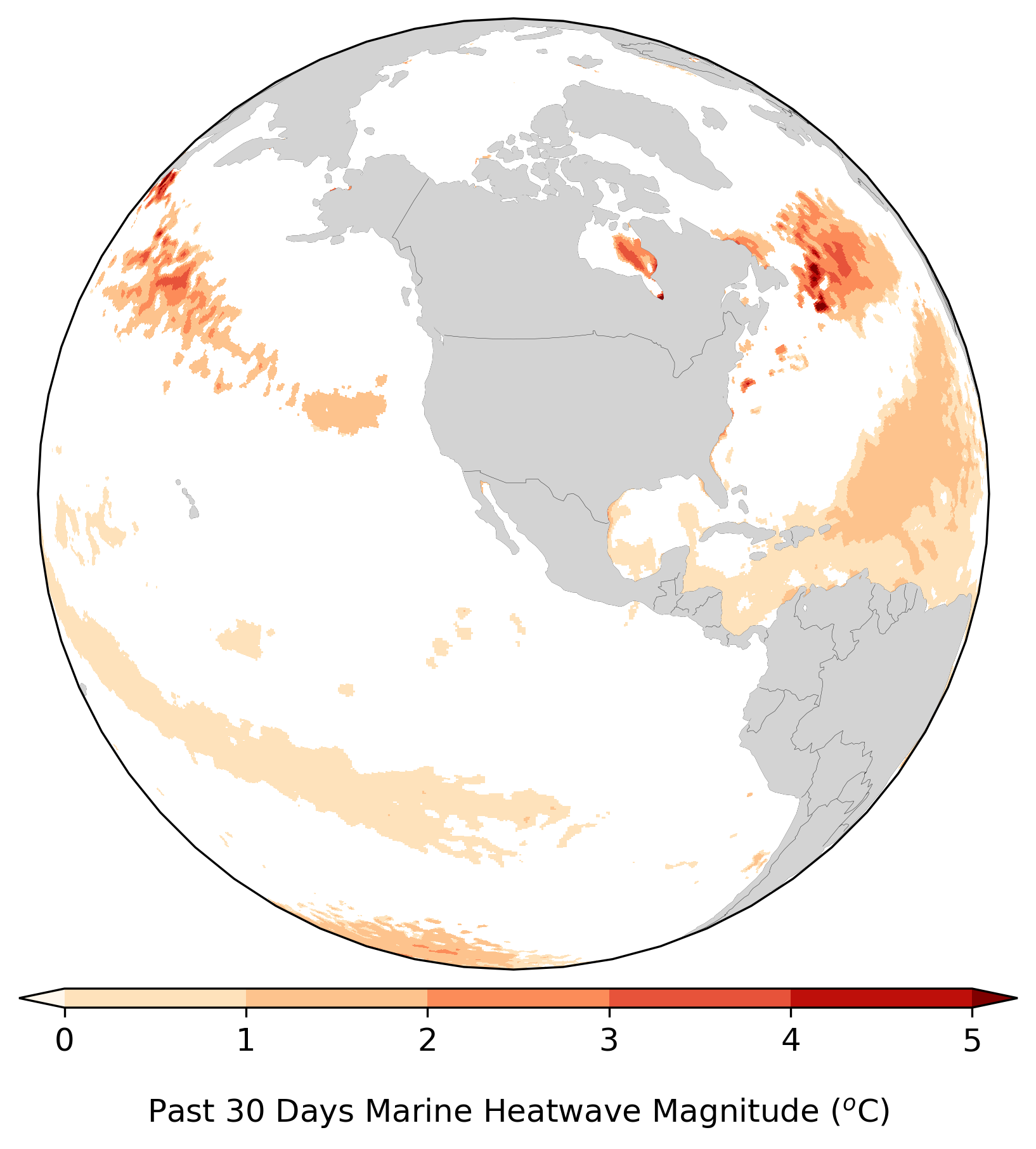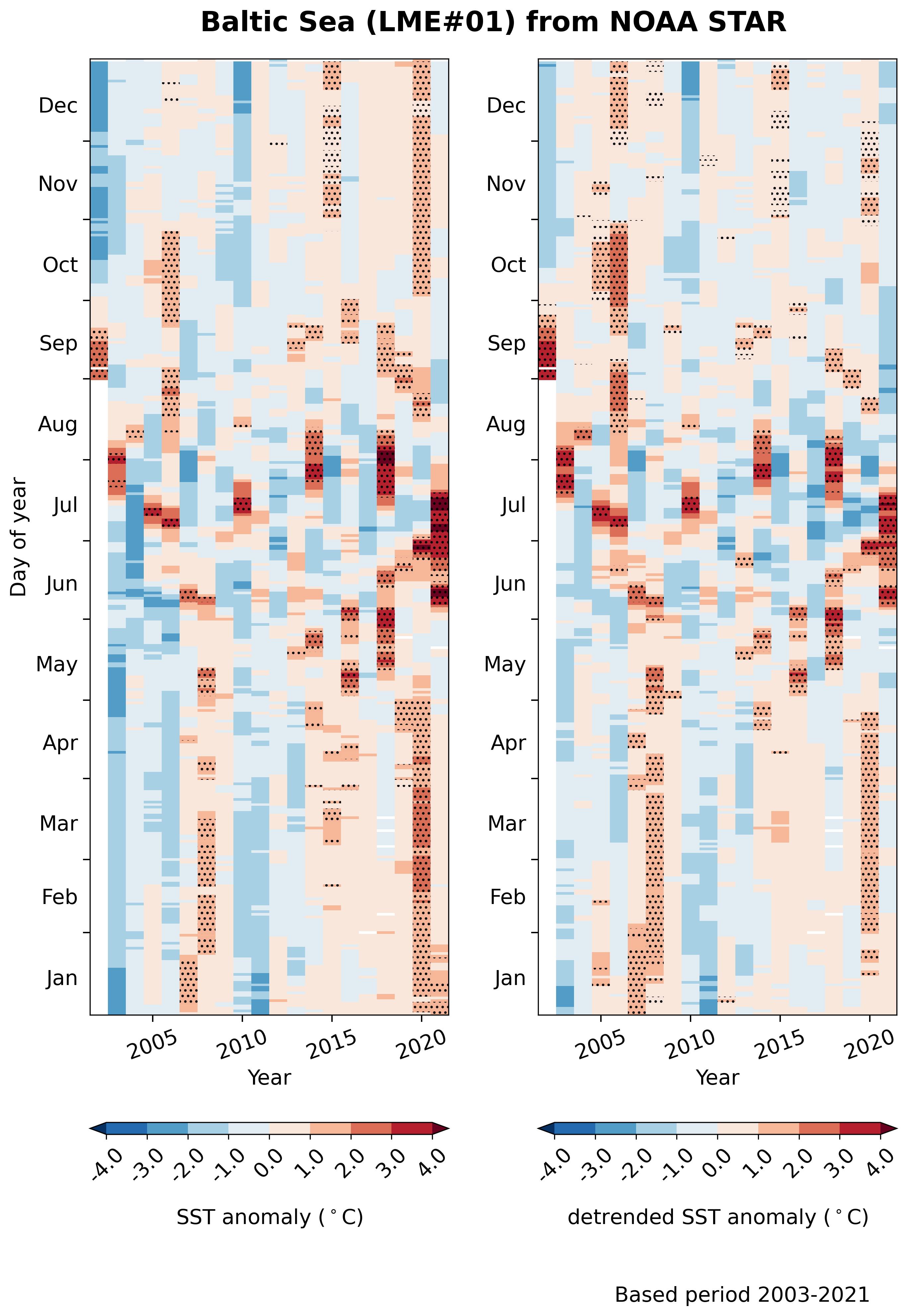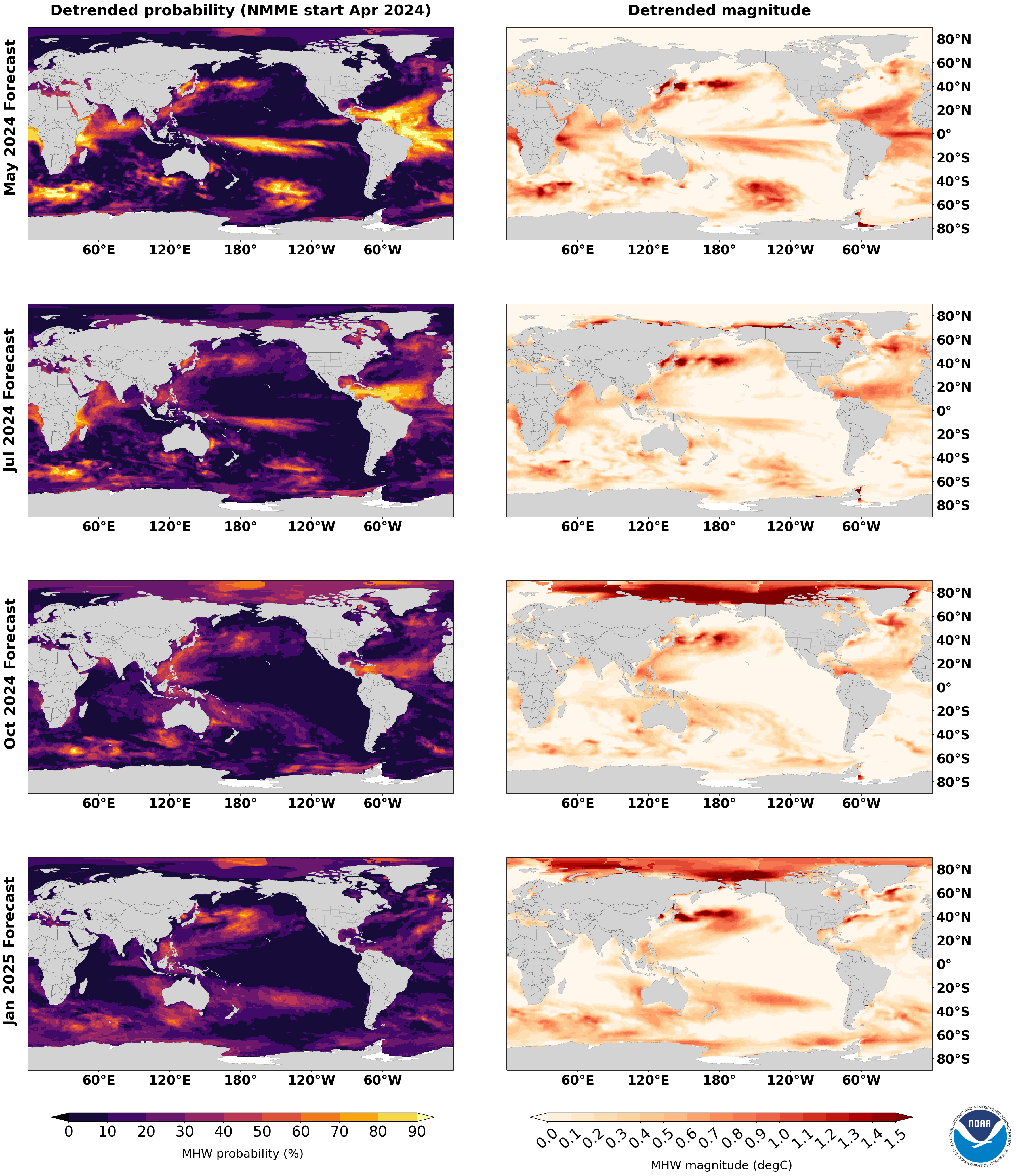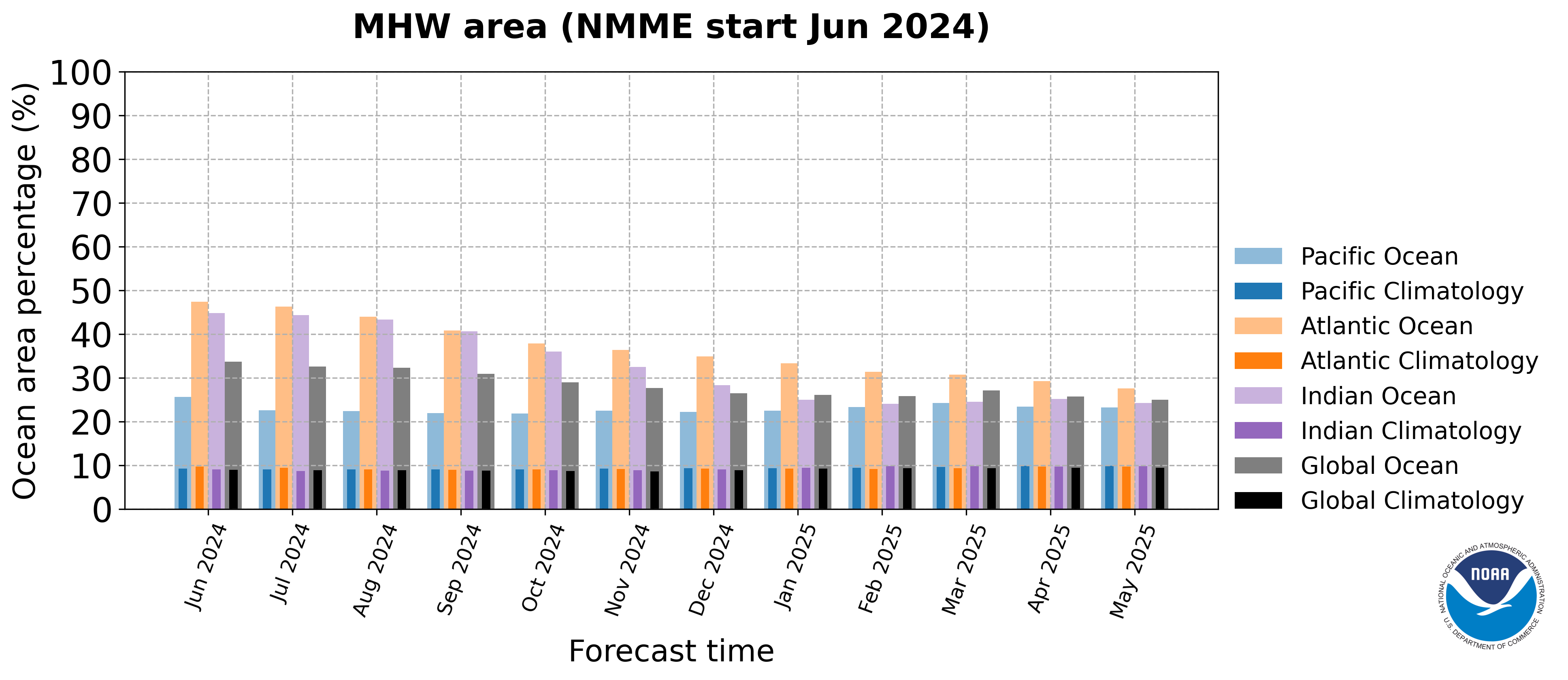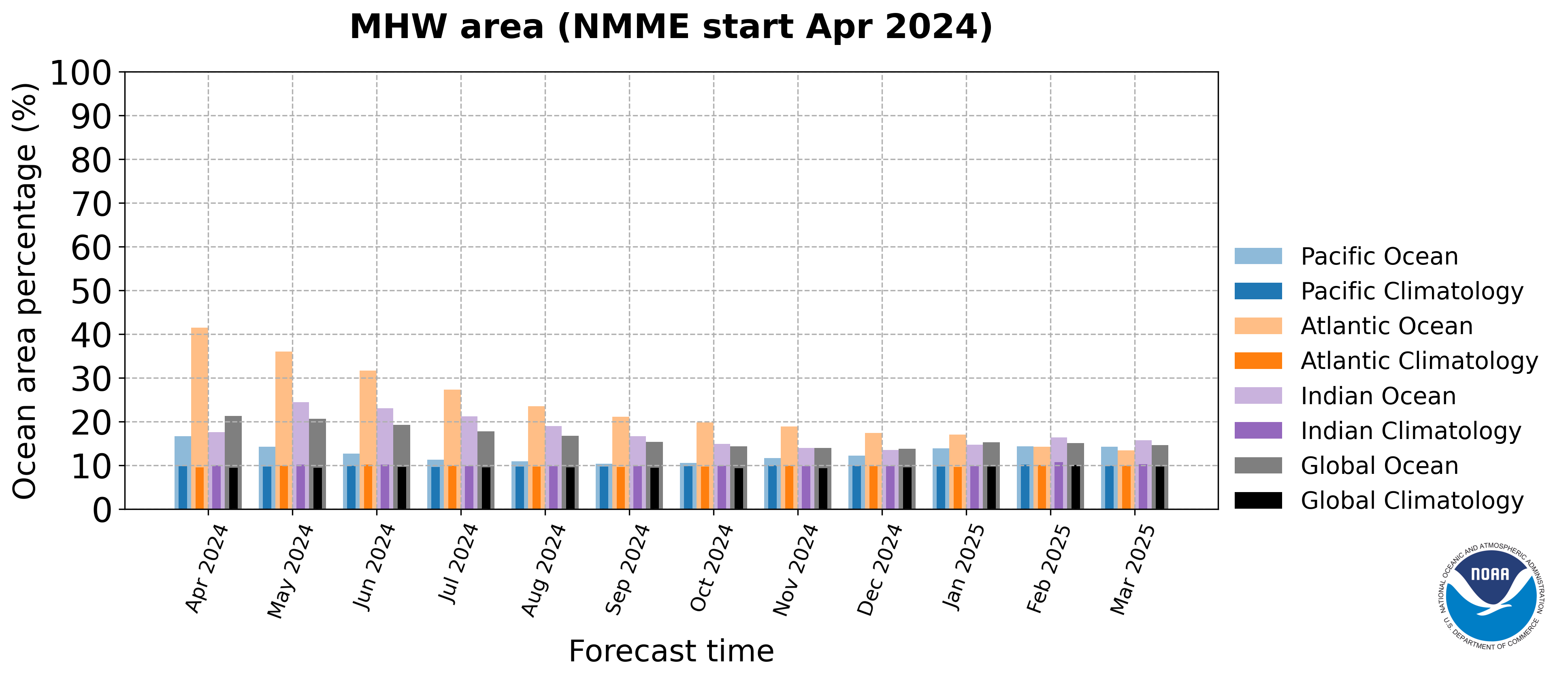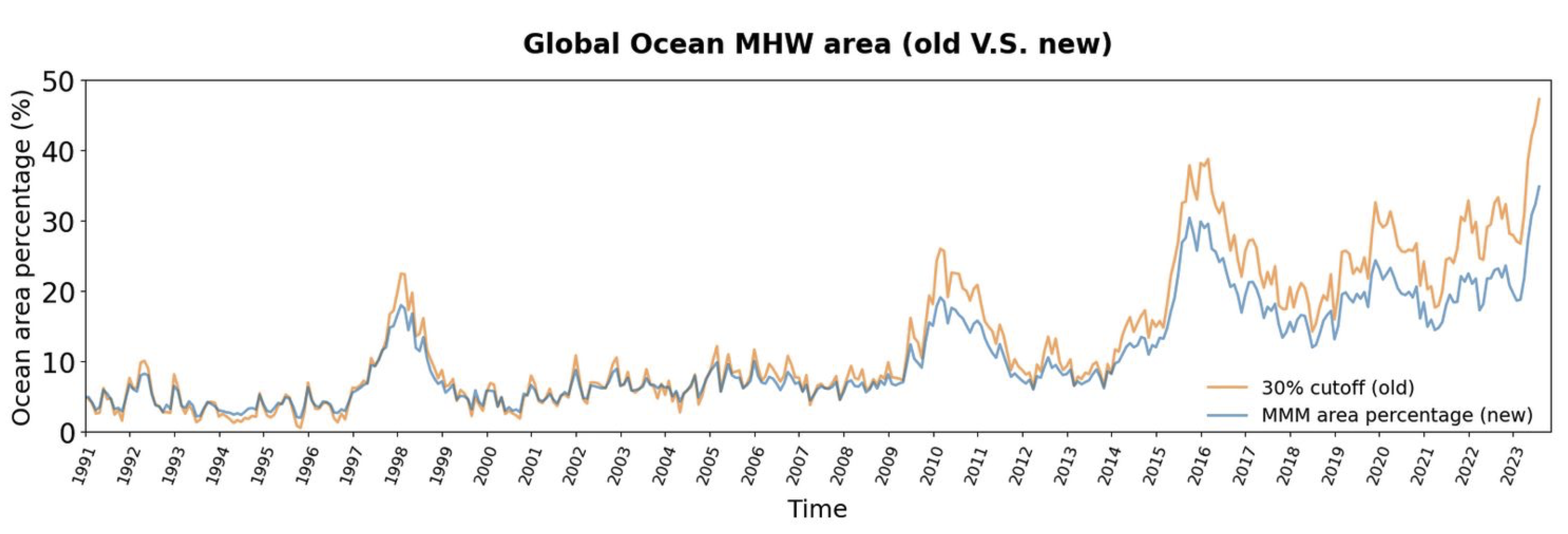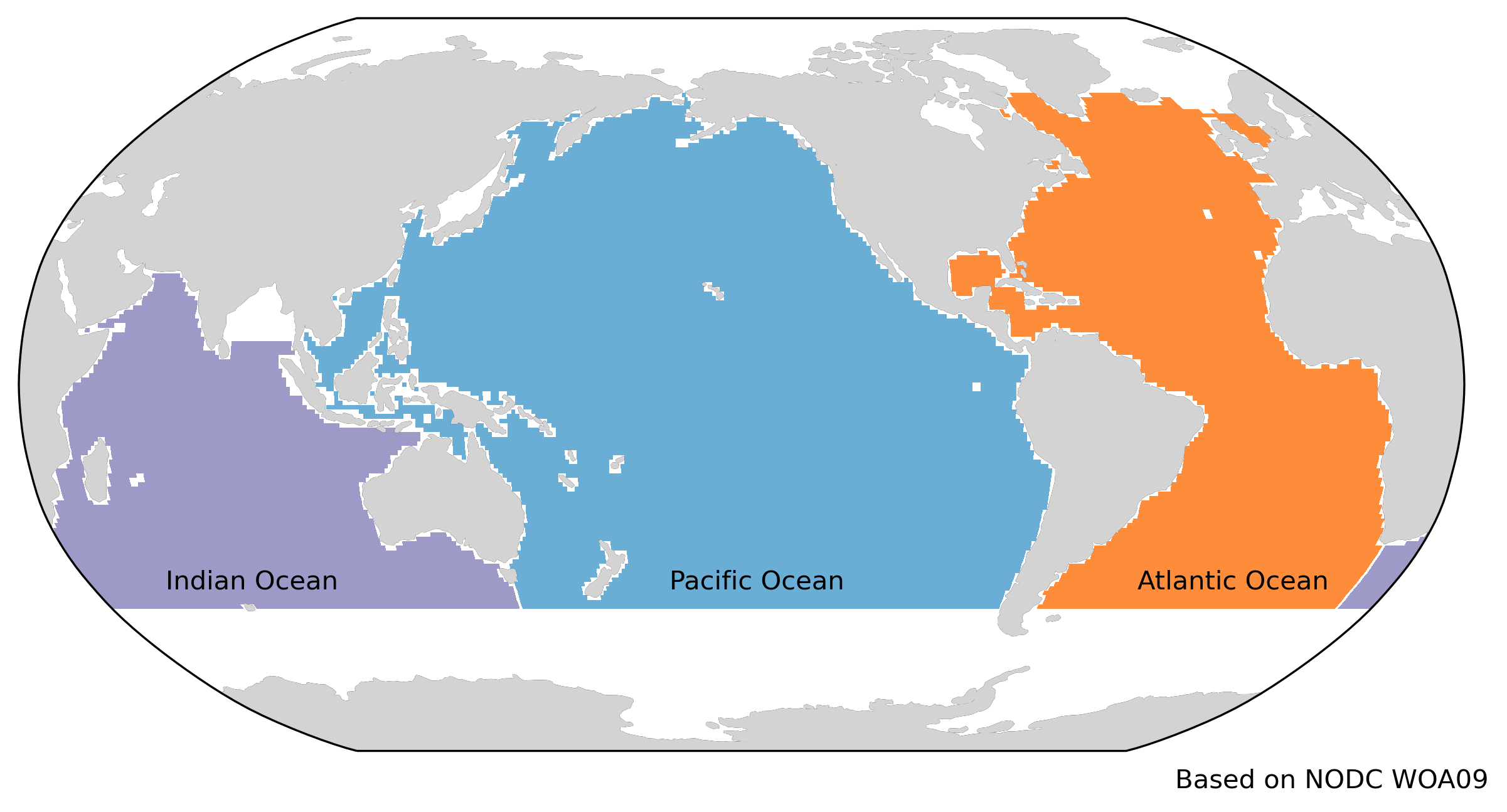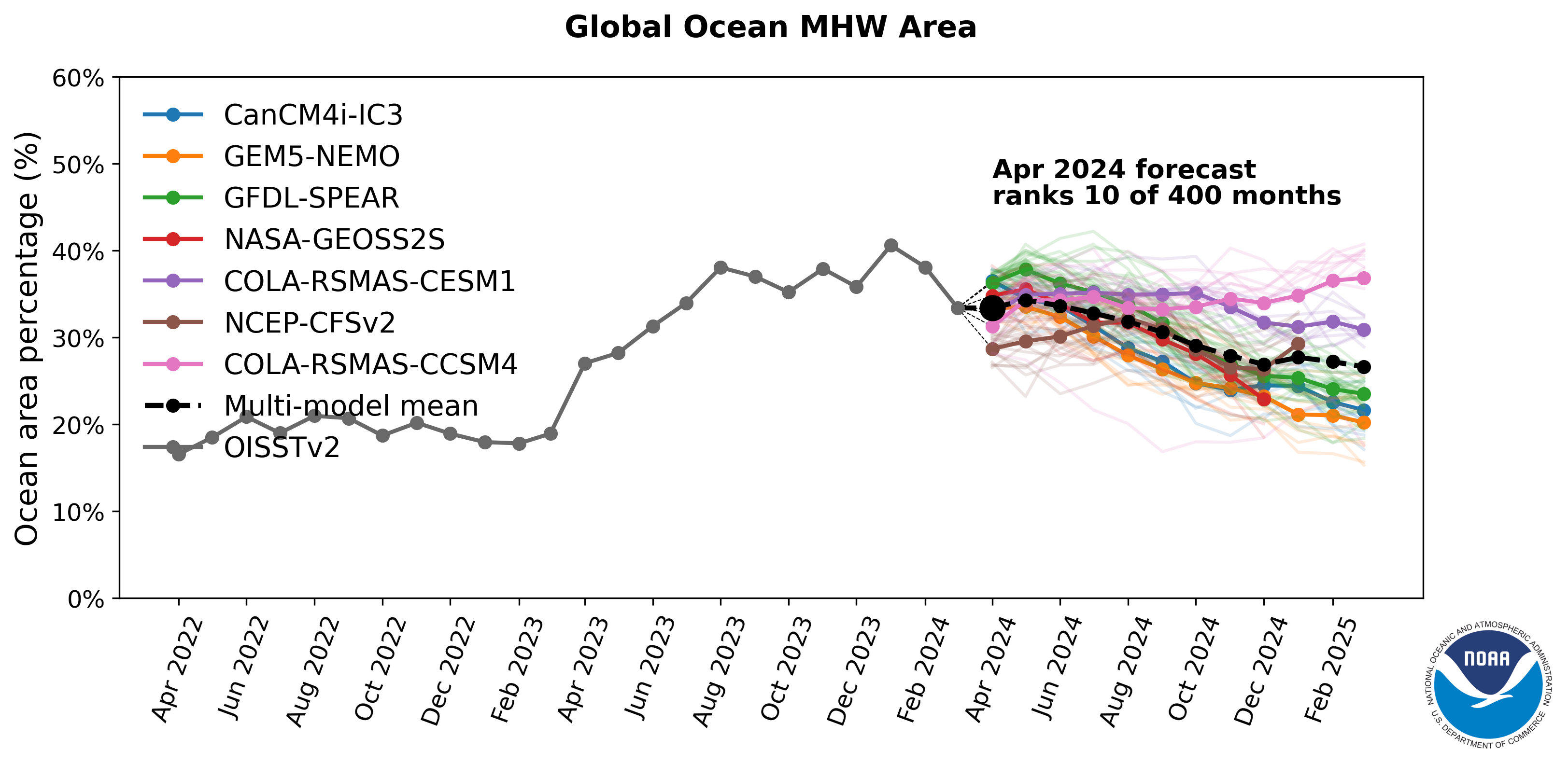Marine Heatwaves
Overview
Marine heatwaves are periods of persistent anomalously warm ocean temperatures, which can have significant impacts on marine life as well as coastal communities and economies. Scientists at PSL are working to characterize marine heatwaves, understand how they form and dissipate, and predict them in advance. On this page, we will provide current ocean maps, forecasts of heatwaves, interactive tools for users to explore ocean heatwaves themselves, links to research results and to webpages at other institutions.
Remove long-term temperature trends?

Click on the image to view global map!
Observed Condition
To reference plot in a publication, please cite as "Image provided by the NOAA Physical Sciences Laboratory, Boulder, Colorado from the website at https://psl.noaa.gov/ ".
Q&A for the interactive tool
- How to interact with the map
- What is a percentile and how is it used to define a MHW
- Why does the sea surface temperature (SST) trend matter
- How to interact with the time series
- What are the rankings
Further questions please contact psl.marineheatwaves@noaa.gov
Forecasts
To reference plot in a publication, please cite as "Image provided by the NOAA Physical Sciences Laboratory, Boulder, Colorado from the website at https://psl.noaa.gov/ ".
Q&A for the forecast tool
- How to interact with the map
- What is marine heatwave
- What models are used to generate the prediction
- Why does the sea surface temperature (SST) trend matter
- What is prediction skill
Further questions please contact psl.marineheatwaves@noaa.gov
High Resolution Sea Surface Temperature
User Options
| Dataset* : | |
| Region† : | |
| Frequency : | |
| Statistic : | |
| Year* : | |
| Month* : | |
| Day* : | |
| Dataset* : | |
| Region† : | |
| Data1 : | |
| Frequency : | |
| Statistic : | |
| Year* : | |
| Month* : | |
| Day* : | |
| Data2 : | |
| Frequency : | |
| Statistic : | |
| Year* : | |
| Month* : | |
| Day* : | |
| Region† : | |
| Dataset1 : | |
| Dataset* : | |
| Frequency : | |
| Year* : | |
| Month* : | |
| Day* : | |
| Dataset2 : | |
| Dataset* : | |
| Frequency : | |
| Year* : | |
| Month* : | |
| Day* : | |
|
Please allow 1 min
for some large LMEs.
|
Time series from:
| Region† : | |
| Longitude : | |
| Latitude : | |
| Dataset* : | |
| Frequency : | |
| Statistic : | |
| Start Year* : | |
| End Year* : | |
| MHW : | |
Visualize time series in:
# presents the time series in a 2-D plan with year in x-axis, day-of-year in y-axis, and color showing the magnitude of the variables.
† (LMEs) map showing the associated ID number and name.
* availability for date (year, month, day) options.
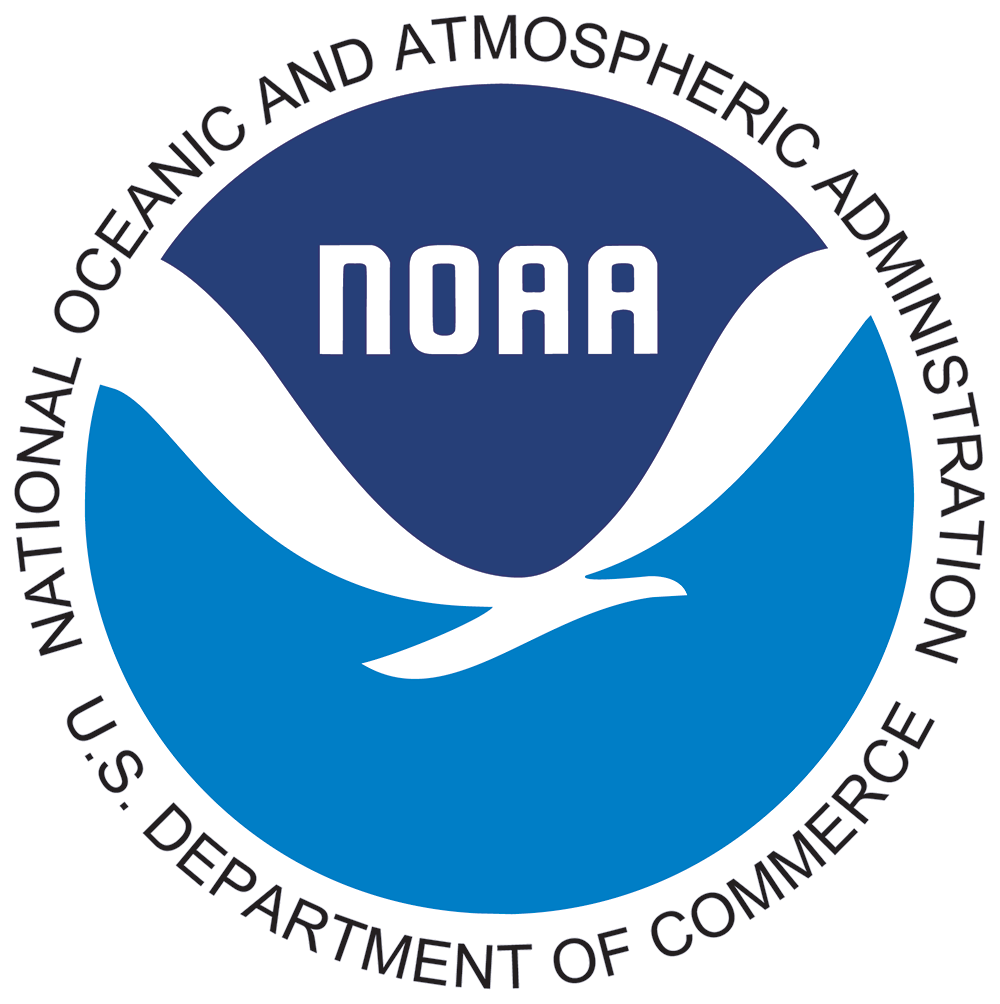
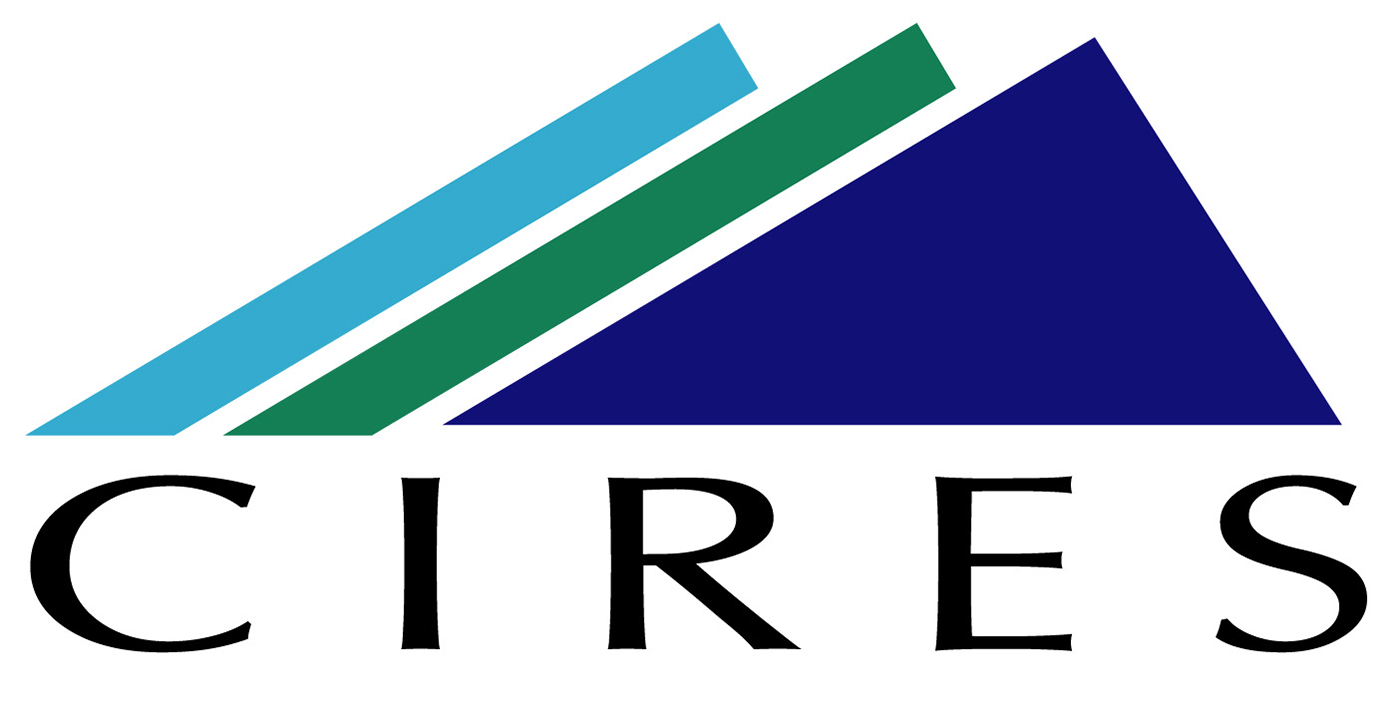
Marine Heatwave Forecast Monthly Report
Global Marine Heatwave Forecast Discussion
Observed and forecasted values include the effects of long-term warming. Values with the long-term warming trend removed are in brackets.
Current marine heatwave conditions:
In February 2025, 32% [17%] of the global ocean experienced marine heatwaves (MHWs), which ranked 16th [44th] among all months since 1991.
The fraction of the globe experiencing MHWs changed little from January to February 2025. MHW patterns are still characteristic of La Niña, with warm water in the far western tropical Pacific extending both northeastward and southeastward across the subtropical Pacific. MHWs are also found across much of the North Pacific east of Japan, in the Sea of Japan, in the central South Pacific, the North Atlantic extending from the South American coast to the south of Iceland, the Caribbean Sea, Mediterranean Sea, parts of the Barents and Norwegian Seas, east of Madagascar in the Indian Ocean, around Australia and in the Indian sector of the Southern Ocean.
Marine heatwave forecasts:
Forecasts predict that MHW coverage and overall intensity will decline slightly in the next couple of months, with approximately 27-31% [12-15%] of the global oceans experiencing MHW conditions over the 12-month forecast period. Below is a regionally refined focus:
- Tropical/North Pacific - MHW likelihoods are low in the eastern tropical Pacific and along the North and South American west coasts through at least May 2025 (0-10% [0-10%]; high confidence). However, MHW likelihoods are high in the central/western North Pacific (70-90% [40-80%]; low-medium confidence) and to a lesser extent in the central/western South Pacific (40-80% [0-50%]; low-medium confidence).
- Tropical/North Atlantic - Elevated chances of MHWs are forecasted into May 2025 in an arc extending from the Caribbean Sea/Tropical Atlantic to the eastern North Atlantic as far north as Iceland (50-80% [10-50%]); low-medium confidence).
- Indian Ocean - Chances of MHW conditions are low over much of the Indian Ocean in May 2025 (<20% [<10%]), with the exception of the northern Bay of Bengal and Arabian Sea, where elevated likelihoods persist (40-70% [20-40%]; medium confidence).
- Southern Ocean - Elevated chances of MHWs are predicted through May of 2025 for the Southern Ocean, primarily in a region southeast of Africa / southwest of Australia (70-100% [60-90%]; low-medium confidence).
How confidence levels are determined
Marine Heatwave Maps
Remove long-term temperature trends?
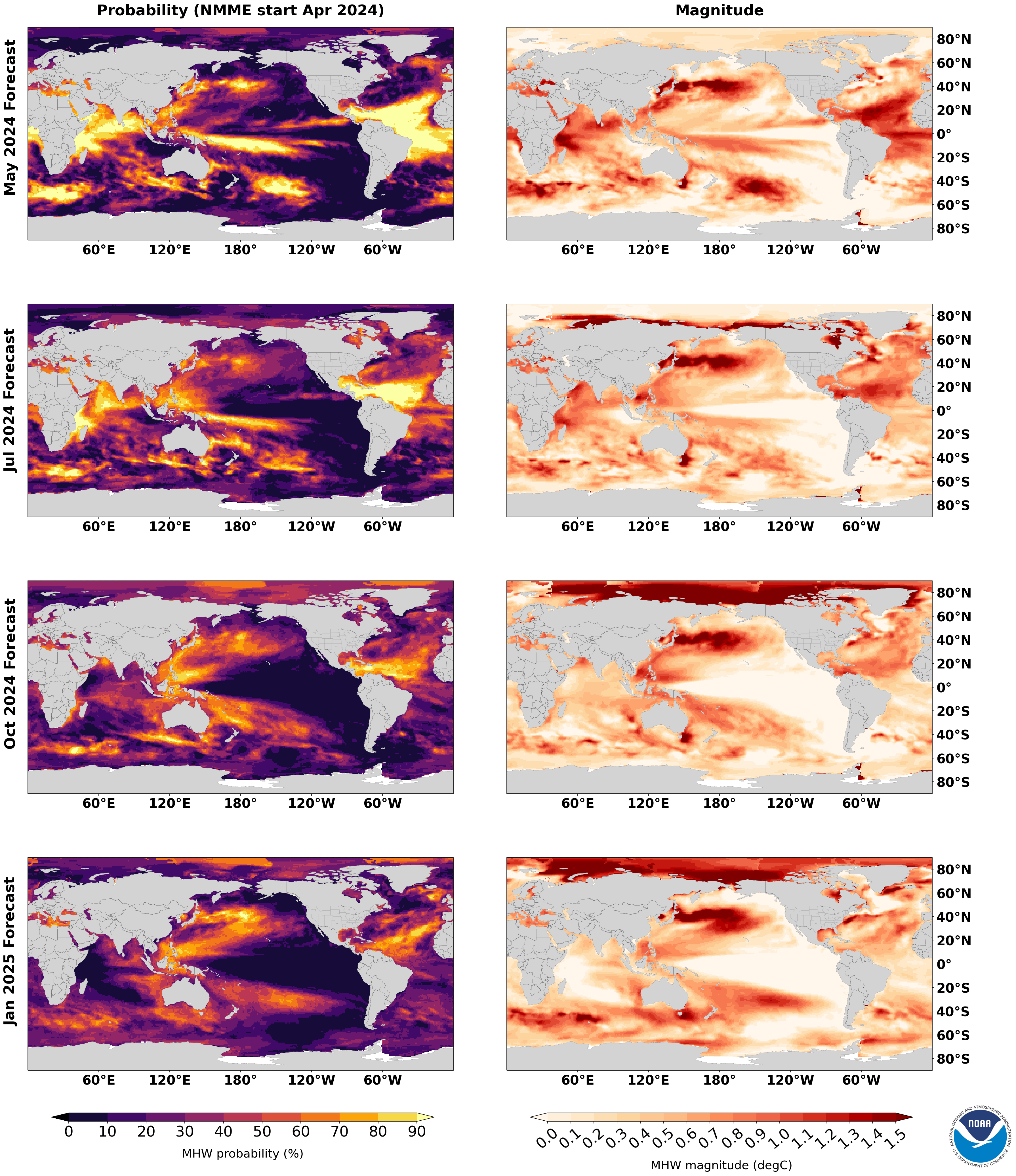
Click on the image to have a full screen view!
Marine Heatwave Area Percentage - Monthly Forecast
How the ocean basins are defined
Remove long-term temperature trends?
Click on the image to have a full screen view!
Marine Heatwave Area Percentage - Historical Record
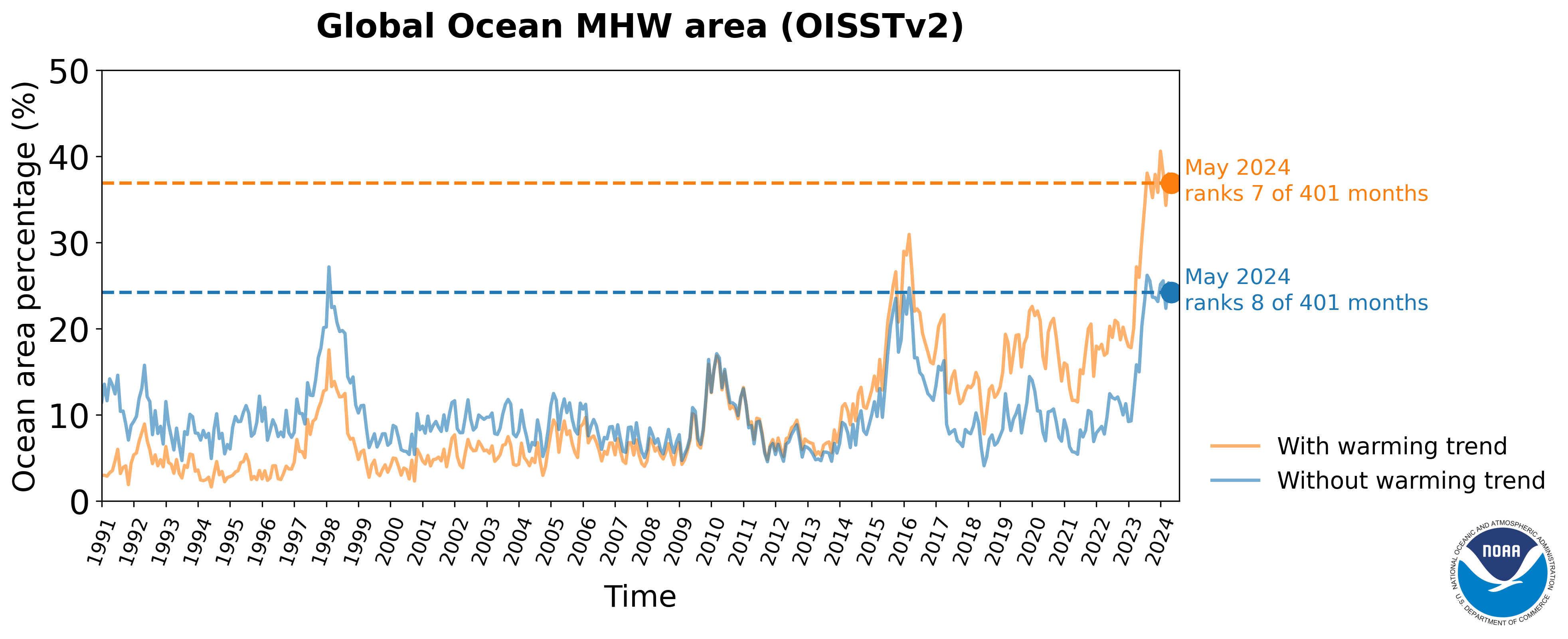
Click on the image to view forecast plume!
Explore
Web Based Tools for looking at Marine Heatwaves
PSL has several web-based tools for plotting and analyzing gridded datasets and timeseries. With these tools, you can extract time-series from different regions, plots maps of means and anomalies, create correlations maps, and analysis time-series. We are also expanding upon what these tools can do.
List of tools
- WRIT Ocean Maps and Vertical Crossections
Allows users to make maps and vertical cross-sections from various reanalyses. Statistics include means, anomalies and climatologies. Users can also difference the various reanalyses for all three types of statistics (for any overlapping date in the reanalyses). Composites (averaging multiple dates) are also available.
- WRIT Ocean Time-series Extraction and Analysis
- WRIT Ocean Correlation Maps Vertical Crossections.
Calculates correlations (and regressions) of the reanalysis and observational dataset with supplied atmospheric/ocean indices or user uploaded time-series. Users can plot correlations at different lead/lags. They can also create vertical cross-section correlation plots.
Extracts timeseries at specified latitude/longitude or latitude/longitude ranges and either plots the time-series, time-series differences, and scatter plots. Various statistics are returned in addition to numeric values of the time-series plotted. Ability to plot and compare climate index time-series such as the PNA or Niño3.4 or upload your own.
PSL Publications
Refereed Papers
- Xu, T., M. Newman, A. Capotondi, S. Stevenson, E. Di Lorenzo, and M. A. Alexander (2022): An increase in marine heatwaves without significant changes in surface ocean temperature variability, Nat. Commun., 13, 7396, https://doi.org/10.1038/s41467-022-34934-x.
- Jacox, M. G., M. A. Alexander, D. J. Amaya, E. Becker, S. J. Bograd, S. Brodie, E. L. Hazen, M. Pozo Buil, and D. Tommasi (2022): Global seasonal forecasts of marine heatwaves, Nature, 604, 486-490, http://doi.org/10.1038/s41586-022-04573-9.
- A. Capotondi, M. Newman, Xu, T., and E. Di Lorenzo (2022): An Optimal Precursor of Northeast Pacific Marine Heatwaves and Central Pacific El Niño Events, Geophys. Res. Lett., 49 (5), e2021GL097350, https://doi.org/10.1029/2021GL097350.
- Amaya, D. J., M. A. Alexander, A. Capotondi, C. Deser, K. Karnauskas, A. J. Miller and N. Mantua (2021): Are Long-Term Changes in Mixed Layer Depth Influencing North Pacific Marine Heatwaves?. Bull. Amer. Meteor. Soc., 102 (1), S59-S66, https://doi.org/10.1175/BAMS-D-20-0144.1.
- Xu, T., M. Newman, A. Capotondi and E. Di Lorenzo (2021): The Continuum of Northeast Pacific Marine Heatwaves and Their Relationship to the Tropical Pacific. Geophys. Res. Lett., 48 (2), 202GL090661, https://doi.org/10.1029/2020GL090661.
- Jacox, M. G., M. A. Alexander, S. J. Bograd and J. D. Scott (2020): Thermal displacement by marine heatwaves. Nature, 584, 82-86, https://doi.org/10.1038/s41586-020-2534-z.
- Jacox, M. G., D. Tommasi, M. A. Alexander, G. Hervieux and C. A. Stock (2019): Predicting the Evolution of the 2014–2016 California Current System Marine Heatwave From an Ensemble of Coupled Global Climate Forecasts. Front. Mar. Sci., 6, 497, https://doi.org/10.3389/fmars.2019.00497.
- Alexander MA, JD Scott, KD Friedland, KE Mills, JA Nye, AJ Pershing, AC Thomas, (2018): Projected sea surface temperatures over the 21st century: Changes in the mean, variability and extremes for large marine ecosystem regions of Northern Oceans. Elementa: Science of the Anthropocene, 6(1):9, http://doi.org/10.1525/elementa.191.
- Scannell, H. A., A. J. Pershing, M. A. Alexander, A. C. Thomas and K. E. Mills (2016): Frequency of marine heatwaves in the North Atlantic and North Pacific since 1950. Geophys. Res. Lett., 43 (5), 2069-2076, https://doi.org/10.1002/2015GL067308.
Marine Heatwave Related Datasets
Marine Heatwave Forecast
The forecast generated by Jacox et al., 2022
- Marine Heatwave prediction from 1991-2020 (with trend)
- Marine Heatwave prediction from 1991-2020 (detrended)
- Ocean and sea ice mask
SST Datasets at PSL
- NOAA OI SST Daily High Resolution.
From 1982, a gridded high resolution daily dataset from NOAA that continues to present.
- NOAA ERSST V5
From 1865, a gridded consistently analyzed monthly dataset from NOAA that continues to present. V3 and V4 are also available
- COBE SST
- COBE-2 SST
- ICOADS
- Kaplan SST
- NOAA OI V2
- NODC 1994 and 1998 atlasses
Ocean Reanalyses at PSL
Ocean Time-series at PSL
News
News Articles about the PSL Marine Heatwave Research and Products
- 07/07/2023: Ocean warming since 1991 doubles the size of the marine heat wave forecasted for September 2023 (Climate.gov)
- 06/28/2023: Global ocean roiled by marine heatwaves, with more on the way (NOAA Research)
- 04/18/2023: El Niño is coming, and ocean temps are already at record highs – that can spell disaster for fish and corals (The Conversation)
- 05/03/2022: Marine heatwaves can be predicted ‘up to a year ahead’ (Carbon Brief)
- 04/28/2022: New research could lead to forecasting of future marine heat waves in the Pacific Northwest (King 5 News)
- 04/20/2022: Marine heatwaves are reliably forecast by climate models (Nature, News and Views)
- 04/20/2022: New Global Forecasts of Marine Heatwaves Foretell Ecological and Economic Impacts (NOAA Fisheries)
- 04/20/2022: Today’s seasonal climate models can predict ocean heat waves months in advance (Climate.gov)
- 04/20/2022: Abnormally warm water could get close to California coast soon (SF Chronicle)
- 04/20/2022: A first as the world warms: New forecasts could help predict marine heat waves (The Seattle Times)
Resources
Links
- The California Current Marine Heatwave Tracker
Developed by oceanographers from NOAA Fisheries' Southwest Fisheries Science Center as an experimental tool for natural resource managers, the California Current MHW Tracker is a program designed to understand, describe, and provide a historical context for the 2014-16 blob. It also produces a range of indices that could help forecast or predict future MHWs expected to impact the CA coast. (NOAA Integrated Ecosystem Assessment) - Marine Heatwave Monitoring and Forecast
Developed by oceanographers from NOAA/NCEP Climate Prediction Center, the webpage provides an overview on the marine heatwave diagnostics based on observational data and marine heatwave forecast based on NMME/CFSv2. (NOAA/NCEP Climate Prediction Center) - Marine Heatwaves Organization
From the Marine Heatwaves International Working Group which is dedicated to understanding marine heatwaves: their physical drivers, climatological properties, and ecological impacts. The webpage summarizes their research. (marineheatwaves.org) - California's Marine Heatwaves FAQ
Explore this FAQ to learn more about what is causing marine heatwaves and their impacts in California. (UC San Diego/Scripps) - Ocean Heatwaves
Key concepts about marine heatwaves with an emphasis on heatwaves and climate change. (Climate Central) - ENSO and Marine Heatwaves
A an interview with two PSL scientists about marine heatwaves, what causes them, how they are impacted by ENSO and how climate change might impact their frequency, among other topics. (Climate.gov) - Looking back at the BLOB: Marine Heatwave
A history of the development of and the demise of the famous "Blob", the 2015-16 heat wave in the NE Pacific ocean. (NOAA Fisheries News)
Code
- Python code that defines marine heatwaves from SST data
Meetings
- Ocean Sciences 2022: Virtual. Feb 24-Mar 4.
- EGU 2022 Vienna, Austria. May 23-30.
This is a Research and Development Application
